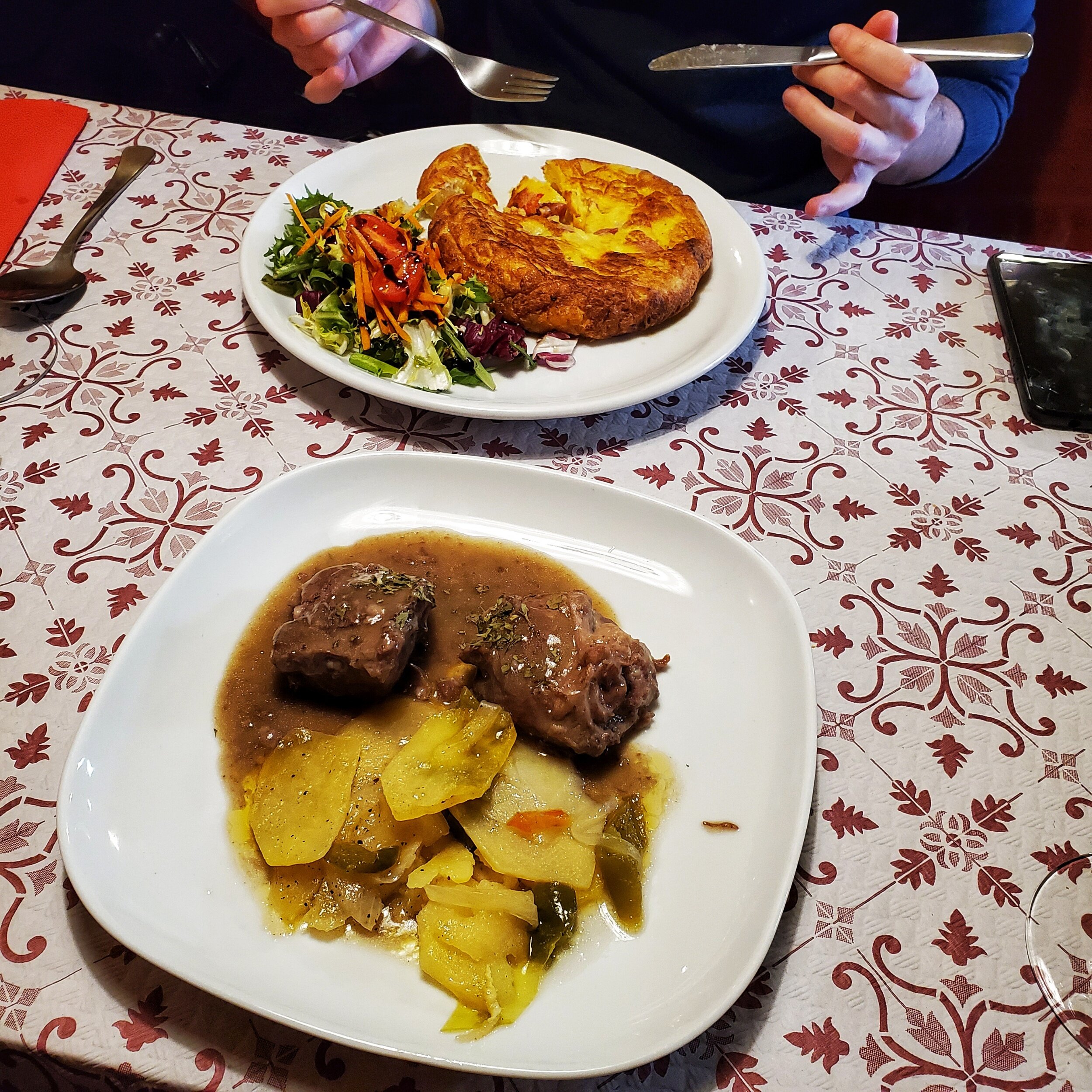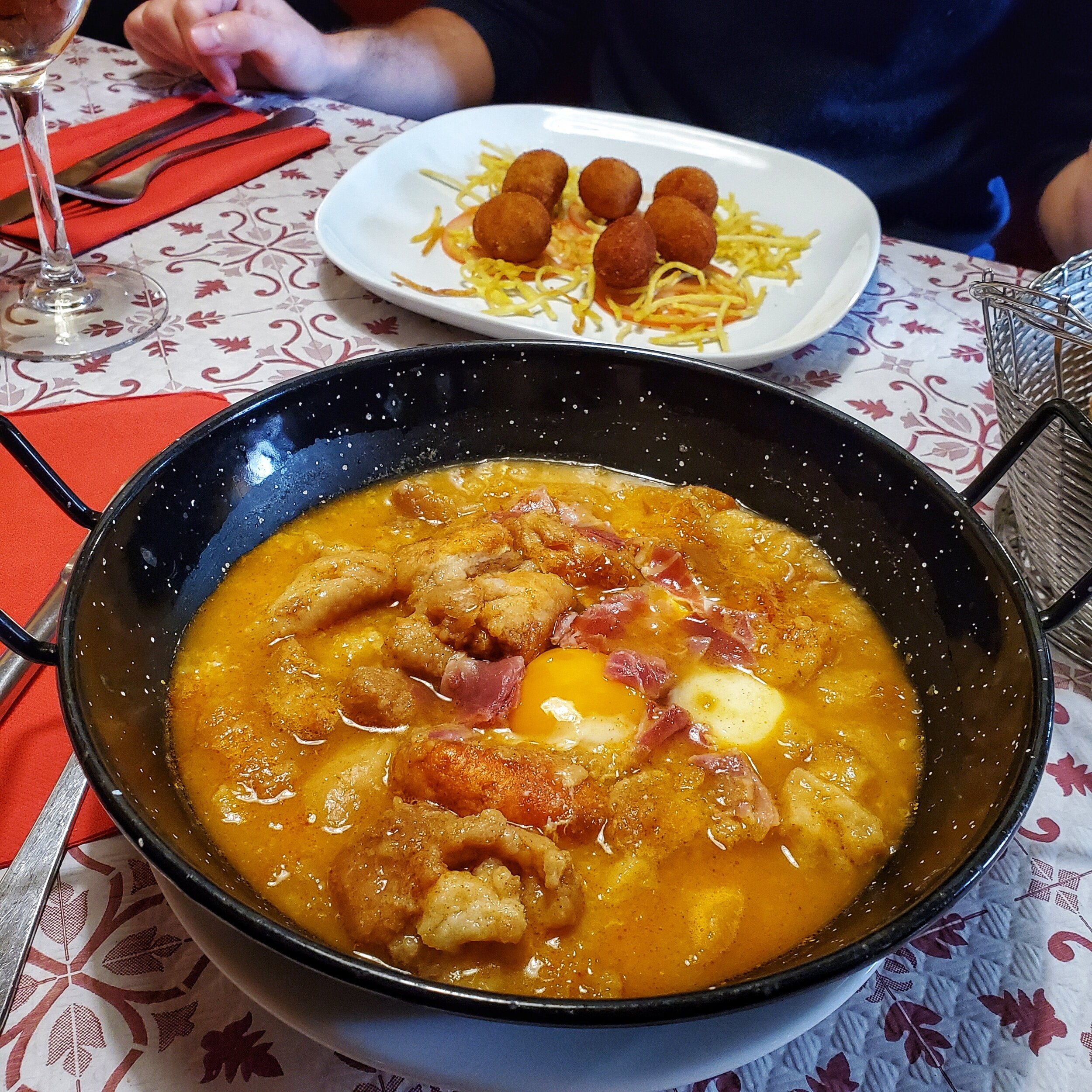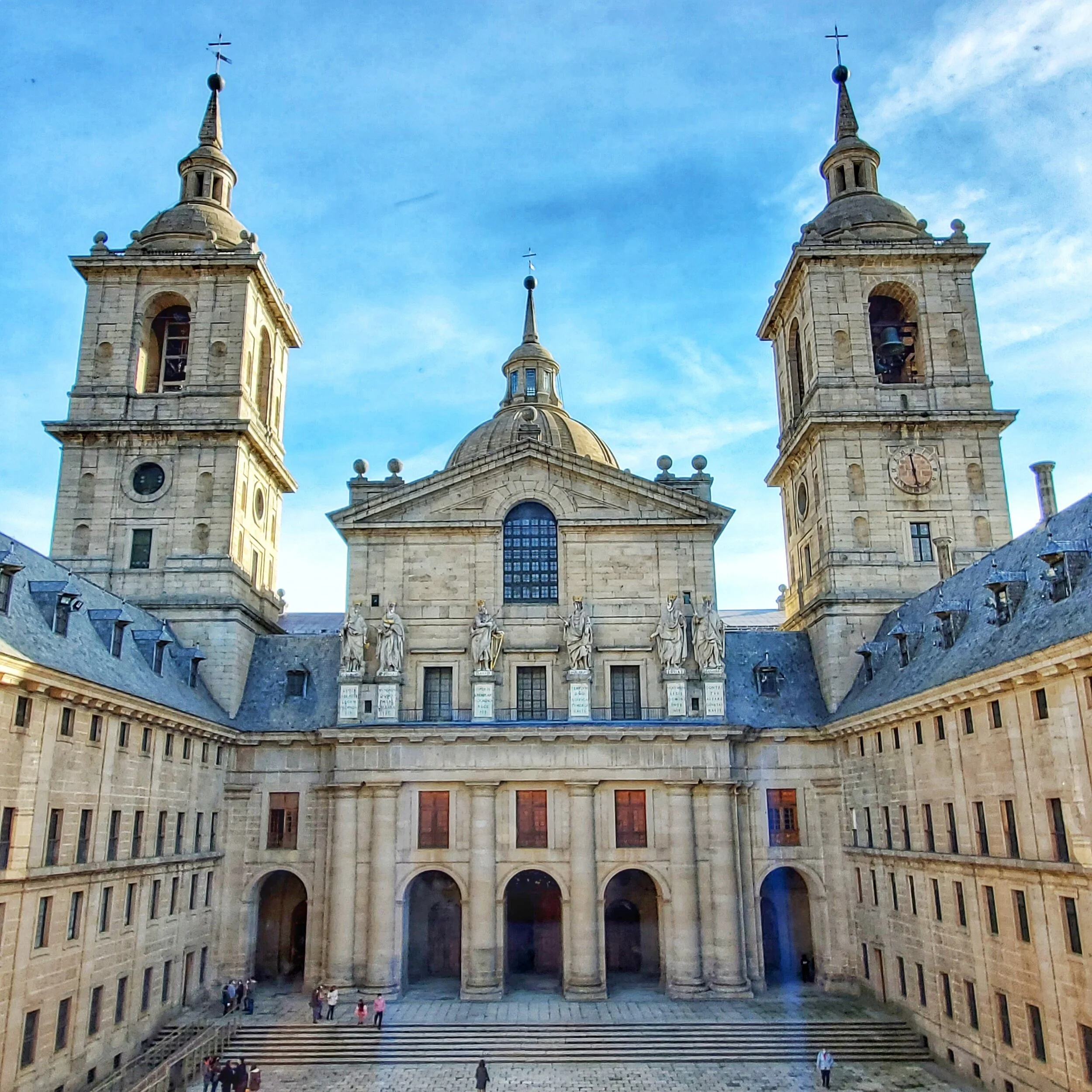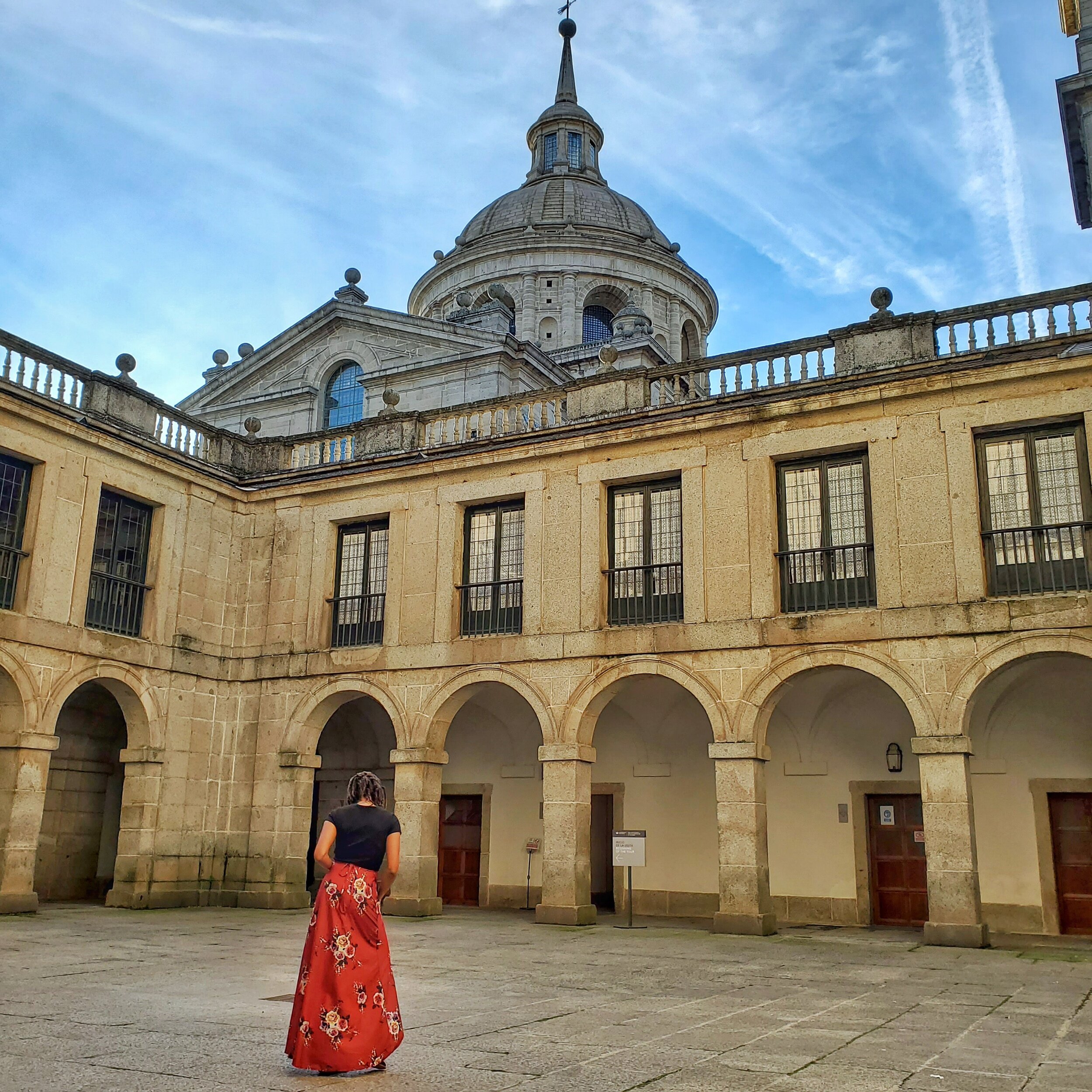El Escorial is a picturesque, 33,327 m² royal palace in central Spain commissioned by Prince Philip II in the 16th century.
Also known by its official name, Monasterio de Lorenzo, El Escorial is still a functioning private residence for the current Spanish monarchs and houses every deceased monarch since the country’s Golden Age.
For travelers of Spain interested in history and breathtaking architecture, the sweeping palace is conveniently located 45 km (28 mi) to the northwest of the Spanish capital of Madrid. El Escorial is easily reachable by local public transportation from the city center so if you want to know all about how to get to El Escorial, then this guide has all you need.
From what to see while touring the palace’s huge grounds to where to get refreshments to replenish your energy levels from all that walking around, you need look no further to plan your ultimate day-trip to El Escorial. ¡Vamanos, chicos!
The History
How to Get to El Escorial
Taking a Self-guided Tour of the Grounds
Courtyard of the Kings
Basilica
Evangelical Courtyard
HABSBURG PALACE
Palace of Prince Philip II
Royal Burial ChamberS
Pantheon of the Kings
Pantheon of the Princes
BOURBON PALACE
THE Hall of Battles
Art Gallery and Museum
Architecture Museum
Royal Library
Garden of the Friars
Where to Eat in El Escorial
Final Thoughts
The History
The Royal Site of San Lorenzo de El Escorial has been a historical residence for the Spanish monarchy since the 16th century, after they had officially reclaimed Spain from the Moors who’d occupied the Iberian peninsula for nearly 800 years. The stunning palace complex is located a mere 2 km (1.2 mi) from the pueblo of El Escorial and consists of the royal palace, a basilica, a monastery, a library, a university, a school, a hospital, museums as well as a pantheon for the deceased monarchs and their descendants.
In 1561, in a move to both symbolize the union of the Spanish monarchy and centralize its political power, Prince Philip II (who would reign from 1556-1598) chose to relocate the Kingdom of Spain’s capital to Madrid. At the same time, he also commissioned Juan Bautista de Toledo to build his royal residence, The latter was a renowned local architect who’d spent the majority of his career in Italy studying under Michaelangelo and working on some other prestigious edifices such as St. Peter’s Basilica in Rome,.
Upon appointing Bautista as “architect-royal” in 1559, Philip and the artist set out to build a complex that wouldn’t only rival other grand European palaces, but also memorialize Spain as one of the most prominent centers of Christianity in the Old World. It’s for this reason that, at one time, El Esociral functioned simultaneously as a royal residence and a Hieronymite Monastery of Order of Saint Augustine.
In reality, El Escorial is made up of two significant architectural sites, the royal monasterial complex, and La Granjilla de la Fresneda, a royal residential hunting lodge, and park. While Philip II decided to have Bautista construct the former on the hillside of Abantos, part of the mountain range of Sierra de Guadarrama, the prince had the architect build the latter a few kilometers away.
Despite neither location being exactly obvious choices for royal residences, Phillip II still sought a majestic palace to commemorate his victory against the French king, Henry VIII, after the Battle of Saint Quentin in Picardy. Moreover, he also desired a place in which to intern his deceased parents, Charles V (the once Duke of Burgundy, Archduke of Austria, King of Spain and Holy Roman Emperor) and Isabella of Portugal (first daughter of King Manuel I of Portugal), along with all of their future descendants.
Although Phillip II was the only Spanish king to ever reside in El Escorial, since its inception, the architectural phenom has served dual purposes since the 1600s. Currently, El Escorial is the final burial for the majority of Spanish kings from the past five centuries, including the prominent cousin-kissing Habsburgs and later the Bourbons.
Owing to its rich history and cultural significance, El Escorial was declared as UNESCO World Heritage Site in 1984, making it the perfect destination for a day trip from Madrid. The Royal Seat of San Lorenzo is one of the most visited attractions in Spain, with over 500,000 visitors annually, so make sure to book your tickets in advance (they’re practically a steal!).
How to Get to El Escorial
If you’re not in the Spanish capital yet, you can fly into Adolfo Suárez Madrid-Barajas International Airport from nearly any other major capital in the world. Upon arrival, you can decide either to head to El Escorial directly to stay in its quaint little town overnight or to spend the night in Madrid.
Alternatively, if you’re already in Spain, you can also use the ever-reliable national rail system run by AVE Renfe to get from one point of the country to the next in just a few hours. Whether you’re coming to Madrid from Barcelona, Cadiz, or Bilbao, there are several departures daily that run between all major Spanish cities in case you need to find out more.
Depending on which day you go, you might even be able to visit the palace for free to check out the timetable below to plan your trip accordingly:
Monday to Friday: 10AM - 4PM, with access to the monastery and palace until 3PM
Weekends and public holidays: 10AM - 6PM, with access to the monastery and palace until 5PM
Free entrance: All day Wednesday during opening hours and Sunday after 3PM
Public gardens: Open daily from 10AM - 6 PM
Merely ensure to buy your tickets in advance as they tend to go quickly since the daily limit for visitors is only a few hundred people. During the high season, slots fill up weeks before as Madrileños roll out in droves to explore their own backyard.
Entrance works via time slots so you will have to carefully choose your arrival in order not to miss your place by showing up late. Either way, plan to visit during the low season or in the morning before Spaniards have had their second cafe con leche.
Understanding the Community of Madrid’s Transportation System
Madrid is actually the capital of the autonomous community of the same name and, thankfully, has one of the best-connected and affordable transportation systems in Europe. The underground metro system is actually the second-longest in Europe after Paris and the sixth-longest in the world, and typically offers safe, reliable travel across the metropolitan area that consists of 12 color-coded lines. The metro lines run from about 6AM to 12AM on weekdays and 6AM to 1AM on weekends.
COST
The metro’s fare is based on distance, with farther destinations costing slightly more to get to from the city center, while the metro map works on a grid of circles called “zonas” that extend outwards from Zone A to Zone C2. The metro system is further complemented by Madrid’s commuter rail system, known as “cercanias,” which provides a connection to nearly every corner of the community. The fare for the cercanias is a bit higher than that for the metro but you can opt to combine them both onto one journey to receive a discount.
El Escorial is located in Zone C1 so you’ll need to take both the metro and the cercanias to get to El Escorial via public transportation. Fortunately, the journey is very stream-lined thanks to the metro’s well-laid-out and easy-to-understand navigational directions.
Once you get to that main entrance for the metro, you must then obtain a plastic Madrid transportation card to load your trips onto it (Madrid went paperless in 2018). Purchase the card at one of the blue or white ticket kiosks which are available in 5 international languages including Spanish, English, French, and German. Thankfully, the card is relatively inexpensive, is valid for all public transportation systems in Madrid, and can be reused whenever you need more trips in the future
After acquiring the card, you must subsequently load up your fare (plus the fee to exit the airport if arriving by plane) to ride the metro. As of this writing, the current fares are:
New Madrid metro card: ~2€
Airport exit/metro entrance fee: ~3€
One-way fare between Zone A to Zone C1: ~4€
Generally, the metro and the cercanias function as separate but interchangeable systems so you can’t access both using a special single-trip ticket unless you buy a day pass (17€ and probably not worth the investment unless planning to bus around El Escorial). At the kiosk, you’ll want to select these options to put in the correct destination:
STEP 1: Switch to your preferred language and then look for the option to purchase a new transportation card.
STEP 2: Once you pay for the card, take it from the dispensary and then place it in the machine’s slot to load your credits. Load the necessary fare from your current location to the closest main station (either Sol, Atocha, Nuevos Ministerios or Chàmartin, about 2-3€). Make sure to pay the airport fee if coming from the airport (about 3-4€).
With any luck, you’re able to load your fare onto your metro card easily (otherwise, ask any other the readily-handy service agents nearby donned in blue and yellow for help) and can now swipe the card to the right-hand side of the tollbooth to enter the metro.
STEP 3: Ride the metro to your intended destination and then exit the metro to find the entrance to the cercanias (a big red “C”). Before you can enter the cercanias, you must locate the white kiosks machines to buy a transfer ticket (only available in paper form). Enter your current destinations and then select El Escorial as your destination to access the long-distance train system (4-5€).
STEP 4: Swipe your way into the cercanias to transfer and then find the platform for the train leading to El Escorial for the last leg of your journey.
From Adolfo Suàrez Madrid-Barajas International Airport
From the arrivals terminal, look around for the signs to your right leading toward the metro station on the far side of the airport. Depending on where you land, you will probably have to cross at least a few terminals before reaching the metro station. At the metro entrance, buy your metro transportation card and load up your fare (as described here), including the airport exit fee.
STEP 1: From the Airport to Nuevos Ministerios Metro and Cercanias Station
After entering the metro system, your first stop is Nuevos Ministerios, one of the most important transportation and commercial hubs in Madrid. Find the metro signs leading toward Line 8 (the pink one) heading toward “Nuevos Ministerios” and then get on the train. Ride the handful of stops all the way to the end of the line, a journey of about 20-25 minutes. Then exit the train to work your way around the maze that is Nuevos Ministerios because next up is hopping onto the cercanias.
STEP 2: From Nuevos Ministerios Station to El Escorial Train Station
The entrance to the cercanias can be found by looking out for metro signs with a huge, red “C” (you can’t really miss them). Remember, you must swipe your card again at the tollbooth to enter the new transportation system and on your way out to exit so keep it handy.
However, be careful to select the correct platform as there are 8 platforms in total and only one of them hosts the C3A or C8 trains, the same ones that go right to El Escorial. Make sure you look out for the train labeled “El Escorial” to roll by every 20 minutes or so, or look up the schedule here. Climb on board and you’ll be whisked away toward your final destination in less than a half-hour.
STEP 3: From El Escorial Train Station to El Escorial Monastery
Once your train pulls into Estación Renfe de El Escorial, you have 3 options on how to reach San Lorenzo de El Escorial, located about 2.8 km (1.7 mi) away. You can either walk (a scenic 40-minute stroll), take a cab (an 8-minute ride and around 6€ in taxi fare), or take a city bus (a 10-minute journey).
ON FOOT
If you prefer to stretch your legs and would like to get acclimated to the quaint town of El Escorial faster, walking to the monastery is a fantastic option. The walk will take you past either the historic Casita del Príncipe or Casa de Ejercicios de San José, both of which offer their own unique beauty, as well as the stunning Plaza de Juan de Herrera.
ON WHEELS
It would undoubtedly be better to take a cab instead of walking if you’re pressed for time. You can find a taxi stand right outside of the train station so just hop into the first cab in line to arrive at your final destination in nearly no time at all.
If you’d rather save a few euros and don’t mind waiting for the bus (the journey is about the same length of time as taking a taxi if you manage to catch it on time), look for the signs pointing toward the bus terminal. Once there, you should look for the boarding gate for ALSA Bus - L1, which goes directly to El Escorial.
If you have any difficulty locating it, simply ask any uniformed attendant, “¿Dónde está la puerta para el autobús hasta El Escorial?” and they should be able to point you in the right direction. The buses come frequently enough and you can pay your fare on board (about 2€) but make sure you have small bills as the driver cannot (and won’t) give change for bills over 10€.
Take a seat or hold on for dear life as you ride the bus two stops and get off at the Estación de Autobuses de El Escorial. Turn around the majestic beauty of the monastery will be just in sight so hurry over at your own pace.
From Madrid’s City Center
If you’re staying in Madrid’s city center, then getting to El Escorial should be a breeze! Either head to either Atocha, Sol, or Nuevos Ministerios or Chamartin Metro Stations (the main train stations going from south to north) via metro transfer, taxi, or on foot.
STEP 1: From THE NEAREST MAJOR TRAIN STATION
Once there, enter to follow the metro signs with a large, red “C” to track down the cercanias and locate their ticket kiosks. Buy a metro card and load up your fare (see instructions here) from Zone A to Zone C1, then find the correct platform heading toward El Escorial (Train C3A platform).
The train comes every 20-35 minutes depending on the time of day or the week but the journey takes only about a half-hour so time your arrival accordingly by looking up the train schedule in advance. Hop on and then wait for the stop announcing your arrival at El Escorial before exiting at Estacion Renfe de El Escorial. The monastery will be just within your reach!
STEP 2: From El Escorial Train Station to El Escorial Monastery
Taking a Self-Guided Tour of the Grounds
Upon arriving at El Escorial Monastery, you have the choice of freely wandering the grounds or hiring a guide for a private tour. The tour is available in multiple languages besides Spanish such as English, French and Italian but when they run depends entirely on the availability of the bilingual tour guide. If they're already occupied giving tours to other groups, then you might find yourself waiting at least an hour until their schedules open up again.
In place of taking an official guided tour, you can stroll around the palace at your open pace with the aid of this complete itinerary complete with factual tidbits about every chamber and grand hall you could possibly stumble upon. If you like historical trivia but don't feel like investing in an hour-long tour to get it, follow this walkthrough of the grounds to visit the most prominent sections of the palace.
Section 1: Courtyard of the Kings
Starting at the main entrance at the center of the western facade, you have 3 doors; one leading to the monastery's school, the other to the monastery, and the central door that opens to the Courtyard of the Kings (el Patio de los Reyes).
Before heading through the middle door, notice the niche on the facade where you can see the carved image of a saint.
Pass through the portal to enter the next courtyard, which is named after the statues of the Kings of Judah adorning the facade of the Basilica of El Escorial, your next destination.
Section 2: Basilica of El Escorial
Access the basilica from the back of the Courtyard of Kings, where the religious edifice has functioned as the central building of El Escorial complex since its inauguration. Like the vast majority of late-era Gothic cathedrals in Western Europe, the basilica was originally constructed in the shape of a Latin cross, the long arm of the cross runs west-east while each of the shorter arms goes north to south with the high altar at the far east end.
However, the layout was later modified by Juan de Herrera to resemble a Greek cross, where all the arms are closer in length.
Note, the Basilica is closed to visitors during Mass but you can feel free to attend the ceremony if you’re religious. If not, try to time your visit between services, or else you might miss out on the glory of this holy site.
When (and if) you’re done taking in the breathtaking architecture of the interior, heading out the way you came to your next stop, which will be to your left when exiting.
Section 3: Evangelical Courtyard
If you weren't able to visit the Basilica, continue through the doorway to the right of its door to eventually stumble upon the splendor of the Main Staircase.
This heavenly gateway was personally the highlight of our time at Escorial for me, featuring a mural honoring the majesty of the Habsburg and Bourbon bloodlines.
After you’ve had your fill of gawking (and if you’re me, posing), head back down the staircase and straightforward right into the Evangelical courtyard. Unfortunately, the Evangelica Courtyard is only open to visitors in Spring and Summer so colder-month visitors will only be able to peek in through its barriers.
Off to the far side of the courtyard, there’s also a convent that houses the nuns that also teach at the school right around the corner from their living quarters (i.e. the world’s shortest commute). Head past both sections (plus the pantheons for now) to venture to Prince Phillip II’s former living quarters instead.
Habsburg Palace
Section 4A: Palace of Prince Philip II
On the other side of the Evangelical Courtyard, you’ll find the entrance to the residence of King Philip II, the only Spanish king to ever live in El Escorial. His chambers are made up of several decorated rooms covered in rich tapestries and linens which would’ve helped to keep in warmth as the monarch was seriously afflicted with gout.
Note the small window to the back of the bedchamber where Philip II could watch mass from above when he was too incapacitated by his affliction to officially attend.
Beside his chamber, you can also find the bedchambers of his eldest surviving daughter, La Infanta Isabel Clara Eugenia, who cared for her father in his old age.
When you’re done admiring the scenery, double-back through the Palace of Prince Philip II to locate your next destination the way you just came to visit the Royal Burial Chambers.
Section 4B: Royal Burial Chambers
Update: In correspondence with the COVID-19 pandemic, as of this writing the Pantheon of Kings is closed until further notice due to lack of proper ventilation. However, the Pantheon of Princes is still open to the general public.
The Royal Burial Chambers are made up of two parts, el panteón de los reyes (the Pantheon of the Kings) and el panteón de los infantas (the Pantheon of the Princes). Together they contain the remains of nearly every notable Spanish king and queen, along with their descendants and court favorites.
Pantheon of the Kings
This chamber is made up of twenty-six marble sepulchers (a type of sarcophagus) that house what remain of the kings of and queens regnant (queens who bore kings) of the affluent (and highly incestuous) Habsburg and Bourbon monarchies.
Beginning with King Charles I of Spain (aka the Holy Roman Emperor Charles V), you’ll be able to trace the Spanish lineage all the way from his reign to the current Spanish king, Felipe VI.
Among the Who’s Who of Spanish royalty, you’ll also see the final resting places of:
Phillip II: the king who commissioned El Escorial, whose parents were first-cousins and whose fourth marriage to his niece bore his eventual heir
Phillip III: Phillip II’s only remaining heir after his older brother, Don Carlos, tried to assassinate their father and died insane (probably from all the inbreeding); he later married his first-cousin who bore his heir
Phillip IV: Phillip III’s eldest son who had 13 children across 2 marriages (the second to his niece) and an affair, but only 2 of whom survived until adulthood
Charles II: Phillip IV’s only legitimate son who was born deformed and sickly, largely due to the fact all 8 of his great-grandparents were descended from the same two ancestors, Philip I and Joanna I; he married twice but died childless as the last Habsburg king (for obvious reasons)
The lineage gets a bit wonky after this point as, with no heirs left to Charles II, the fate of the Spanish crown fell into turmoil. At last, Charles II’s older half-sister, Maria Theresa, abdicated her right to the throne to allow her grandson, Phillip V, to ascend, establishing the reign of the Bourbon dynasty.
King Philip V is one of two Bourbon kings not buried at El Escorial (including Ferdinand VI, his youngest son from his first marriage) but the rest of their offspring are, such as:
Louis I: Phillip V’s eldest son from his first marriage who died 7 months into his reign due to smallpox, causing his father to reclaim the Spanish throne until the latter’s death
Charles III: Phillip V’s fifth son and first from his second marriage who became king upon the death of his older half-brother Ferdinand VI
Charles IV: Charles III’s second son who became king due to his other brother’s various mental and physical disabilities (again, all that incest)
Ferdinand VII: Charles IV’s eldest surviving son who was born and died in El Escorial and whose fourth marriage to his niece bore his heir
Isabella II: one of two of Ferdinand VII’s surviving heirs and the first Spanish queen in nearly 300 years
Alfonso XII: Isabella II’s eldest son who paternity is still long-disputed
Alfonso XIII: Alfonso XII’s only son who was born king due to his father’s death the previous year
Check out all dates on the headstones to see if you can piece all their reigns together!
BONUS FUN FACT #1: It should be noted that King Amadeus is also missing from the pantheon since he only reigned in Spain for a few years between Isabella II’s abdication and the ascension of her son, Alfonso XII.
Moreover, although tradition states only queen regnant can be interred in the Pantheon of Kings, an exception was made for Elisabeth of Bourbon, who died before her son who also died before he could be crowned king (she’s still Phillip V’s great-grandmother and a direct ancestor to the King of Spain now, Felipe VI).
BONUS FUN FACT #2: There’s no longer any more space for any more Spanish kings and queens to be buried so they have nowhere else to go!
Pantheon of the Princes
This section of the burial chambers is a newer addition, constructed in 1888, and consists of nine burial chapels. These contain the remains of Spanish princes, princesses, and their consorts that are literally too many to name.
However, among these you’ll find the most recent additions, such as Infante Alphonse in 1992 after he was “accidentally” shot by his younger brother, Juan Carlos I. Juan Carlos I would later become king before being forced to abdicate thanks to numerous scandals, yet his son, Felipe VI, still sits on the throne.
BONUS FUN FACT #3: In 1994, King Juan Carlos I also promoted his cousin, Carlos the Duke of Calabria, up to Infante status so he could be interred at El Escorial upon his death in 2015. The act of nepotism drew strong criticism from other government officials but how’s that for cojones?
BOURBON PALACE
Section 5A: THE Hall of Battles
This next room’s walls are entirely lined with eye-popping art that depicts some of the most significant Spanish military victories in history, including a medieval victory over the Moors.
Get an eyeful of the colorful Fresco-style paintings of scores of armored soldiers atop noble steeds that range from the valiant to the macabre (poor Moors).
Spot King Philip II among the throng as many of the paintings also feature his copious campaigns against the French army.
When you’ve had your fill, head out the other door to continue to the next part of the place. Note, no pictures are allowed in the Hall of Batttles (the attendants were super admanant about it).
Section 5B: Art Gallery and Museum
Take a stroll around this gallery of the finest European art collected by the Spanish Royal from the 15th-17th centuries.
This art gallery includes two wings so at the entrance head either through the door to your left or your right to eventually loop back around to your starting point.
While you’re wandering, make sure to check out some works from Spanish, Venetian, German, Flemish, Lombard, and Ligurian artists such as El Greco who was known for his signature long-aspect ratio portraits.
When you’re down gazing at all the scenery, head out to the Architecture Museum to get another eyeful of artistic splendor.
Section 5C: Architecture Museum
Eleven rooms make up El Escorial’s Architecture Museum and each house a monolith of relics used to construct the entire estate. Get a look at the antique tools, ceiling-high cranes, and other building materials, including reproductions of El Escorial’s blueprints as supplementary documents.
Given the available technology at the time the construction of El Escorial is still an impressive feat so take your time to appropriately gawk. When you’re done geeking out over astonishing architecture, head out the way you came to get some enlightenment at your penultimate destination.
Section 6: ROYAL Library
El Escorial houses three libraries, one situated behind the Chorus in the basilica and another within the monastery that is predominately used by the Augustine monks. Still, the most beautiful would have to be the Royal Library which was meant to be a public work of art that was commissioned by Juan de Toledo and Juan de Herrera, the most distinguished architects of the time.
Overlooking the Courtyard of the Kings, the library was the most modern of the age, being the first in Europe to break away from traditional medieval designs. As was Juan de Herrera’s typical style, he decided to redraft the exterior and entire distribution of the project several times since it was supposed to be the heart of the facility along with the basilica.
I’d say it was worth the effort since, after visiting El Escorial’s Library, Domenico Fontana was apparently so taken with its intricate designs that he copied that layout for the library at the Vatican. Take a leisurely stroll through the opulently-painted interior but be warned, no pictures are allowed inside (can’t say I didn’t try though lol). The Royal Library goes only one-way so head out the other end to get some fresh air at your last destination.
Section 7: Garden of the Friars
This majestic courtyard is located right outside El Escorial’s main entrance and was designed by royal decree from Phillip II, who was apparently a huge nature-lover.
He wanted the massive garden to be the perfect paradise to relax and meditate away from all the political scandals and social unrest that inevitably arose in the Spanish high courts (his eldest son did try to plot his assassination, after all).
Stop and smell the roses and the other botanical flowers that bloom throughout the area in spring and summer before getting lost in a hedge maze. Fair warning to those with limited mobility, however, as the courtyard meets a dead-end so the further you walk in, the longer it’ll take to walk out.
Still, it’s definitely worth exploring if you enjoy the outdoors as much as I do (check out the video below!). Eventually, double-back to return to the entrance or wander around the garden’s grounds some more until you’ve had your fill of its natural splendor.
BONUS FUN FACT #4: The Garden of the Friars is open to the general public without the price of admission to the complex so plan a picnic there for free whenever you want!
Where to Eat in El Escorial
The area around El Escorial is practically bursting with restaurants and bars that stridently cater to ocal travelers looking to grab a bite or una copa (a drink) after touring the palace complex for hours.
As often happens with popular tourist destinations, prices can be inflated compared to other restaurants, particularly in Spain, and some placesdon’t offer the best quality for their bills. I’ve got you covered, however, with the best fine dining in El Escorial that won’t break your piggy bank and will leave you only craving for more.



Taberna Restaurante Madrid-Sevilla
We went to this traditionally Spanish tavern, which offered some classical local fare such as sopa castellana (a Castellon-style stew), tortilla a la paisana (country-style Spanish potato omelet), or solomillo de cerdo en su salsa (pork loin in its own sauce). The prices were reasonable for Madrid its location and their service so why not also get the flan for dessert? You won’t be disappointed.
Address: Calle Dr. Mariano Benavente, 1, 28200, San Lorenzo de El Escorial, Spain
Mesón La Cueva
Hang out on this Spanish eatery’s wide terrace to soak up the sun while sampling some tasty traditional dishes, like cordero asado (roasted lamb), callos a la madrileña (Madrid-style slow-roasted meat stew), or alcachofas naturales con jamón (roasted artichokes covered in ham). No matter what you pick, you’re sure to be happy with the combination of sunny weather and sumptuous cuisine.
Address: Calle San Antón, 4, 28200, San Lorenzo De El Escorial, Spain
Restaurant Charolés
This restaurant specializes in seasonal cuisine that has helped it keep its well-earned reputation along with its classical stone walls and old-school decor. Order the Buey steak tartar or the confit de pato azulón a la naranja (orange-roasted duck). If you’re looking for traditional Spanish cuisine like your abuela used to make, this is the place to go!
Address: Calle Floridablanca, 24, 28200, San Lorenzo de El Escorial, Spain
Cava Alta Fusion
If you’re a fan of Mediterranean cuisine, then this fusion restaurant will be right up your alley as it offers a delicious mix of dishes from all across southern Europe. If you want to sample the best Spanish plates, get the cocochas de merluza (a Basque-style hake stew) or paletilla de cabrito asado (roasted goat shoulder). Either way, you can’t go wrong, so enjoy the artistic decor and glass-paned dining room as you chow down.
Address: Calle Floridablanca, 17, 28200, San Lorenzo de El Escorial, Spain
Valhalla Experience
Craving traditional Mediterranean cuisine with a new-wave gastronomic flare? The Valhalla has everything you coils ask for and more, serving up favorite dishes. Their menu typically features two tasting menus made of 10 to 12 courses, all more mouthwatering than the last. If you really want to go all out for your tastebuds, you won’t find anywhere better.
Address: Calle Peregrinas, 21, San Lorenzo de El Escorial, 28280, Spain
Final Thoughts
El Escorial is definitely worth a visit for tourists staying in Madrid. The palace makes for an excellent day trip from the city center and is easy to reach via public transportation.
If you have a little more time in the area, I'd additionally recommend stopping at La Silla de Los Reyes, a lookout just a couple kilometers from that palace. At the vantage point, which offers a panoramic view of El Escorial and its surroundings, and was historically a favorite spot of the Spanish kings to look upon their kingdom, you can sit like a royal just like I did.
May you get lost in the wonder,
M






















